
March 10, 2019 Ryukyu Shimpo
By Manato Akira and Sumire Shimaoka
Facts demonstrating that the issue of soft ground in Oura Bay will lengthen the construction period of the Futenma Replacement Facility (FRF) in Henoko, Nago City, have been coming to light one after another.
The Japanese government predicts that ground reinforcement alone will take about five years’ time, yet the Okinawa Prefectural Government (OPG) will not approve the application for the revised construction plan necessary to carry out this ground reinforcement.
Inflation of both the construction period and the construction cost is unavoidable, and so the government’s justification for advancing Henoko relocation, namely, “returning Futenma Air Station and removing the danger as soon as possible,” is crumbling.
Time projected in the Japanese government’s initial FRF plan was eight years total, five of which would be spent on land reclamation, and three of which would be used for establishing facilities.
However, upon simple calculation it has been found that dealing with the soft ground will expand the timeframe to more than thirteen years.
The OPG independently made a preliminary calculation, which was in agreement with the central government’s calculation of “thirteen years.”
Revised Construction Plan
According to the work schedule in a report issued by the Ministry of Defense (MOD), ground reinforcement is extensive and has been separated into two phases.
It is estimated that one phase will take approximately three years and eight months’ time, and 63,155 sand pillars driven into the soft ground from large work ships on the water, to strengthen the ground.
Additionally, the second phase involves a section of shallows where ground reinforcement is necessary, but in which a large ship cannot operate.
Once land reclamation is completed the MOD plans to drive in 13,544 sand pillars into this section.
This process should take about one year. Both phases together should take approximately five years.
There is mention of the section of shallows in the MOD report, which specifies that ground reinforcement from on the ocean is to take place before reinforcement in the shallow section.
It is anticipated that these two ground improvement operations will not take place simultaneously.
The Japanese government will apply to the OPG for approval of the revised construction plan.
These ground improvement operations can start after the application is approved.
Okinawans once again demonstrated their opposition to the Henoko base in the February prefectural referendum.
The MOD assessed, “The governor cannot exactly put his stamp [of approval] on the revised plan.”
If ground reinforcement work cannot start, construction of the FRF will fall behind schedule.
77,000 sand pillars
In the MOD report there was mention of the Tokyo International Airport (Haneda Airport) as a comparative example to the ground improvement work in Henoko, which will require approximately 77,000 sand pillars.
Even at the opening of deliberations in the National Diet, the MOD explained that the ground improvement work in Henoko is feasible, and emphasized that the number of sand pillars are “few.” It cited past ground reinforcement examples, including approximately 250,000 pillars used at Haneda Airport, about 1.03 million pillars used one time at Kansai Airport, and approximately 1.20 more pillars used on a second occasion at Kansai Airport.
Associate Professor Shoji Kamao of Nihon University, who specializes in geotechnology, refutes: “The scale of the land reclamation area at Haneda Airport was different, so naturally the number of pillars differs.
It is not an issue of the number of pillars but of their depth; the deeper the pillars go the more difficult construction becomes.”
At its deepest point, the place where ground reinforcement work is needed in Henoko reaches a depth of 90 meters below sea level.
However, the MOD claims that ground reinforcement is only necessary to a depth of 70 meters, because below that point is a firm layer of clay and reinforcement there is unnecessary.
Nonetheless, the Kansai Airport example does not have as deep a ground reinforcement site as Henoko, and even now 10 centimeters of ground subsidence occurs each year and is immensely costly to repair.
The MOD has given consideration to countermeasures should land subsidence occur after completion of the project in Henoko, and it is possible that it may require additional costs for repair.
Professor Kamao warned, “It is projected that land subsidence will occur long-term, so if appropriate countermeasures are not taken the structure will become unsafe.”
(English translation by T&CT and Erin Jones)
Go to Japanese

March 11, 2019 Ryukyu Shimpo
By Kyoko Ishii
After opening up a large early lead at ten under, Mamiko Higa flirted with disaster over the next five holes dropping six strokes with two double-bogeys and three bogeys with only a single birdie mixed in.
With only two holes remaining, four competitors had climbed into a tie for second a mere two strokes back. Winning the Daikin Orchid Ladies Golf Tournament, a dream since Higa was a child, would not be simple.
“My body was so tense,” it is almost hard to imagine. After the back-to-back bogeys, a murmur of “unbelievable” could be heard from the crowd as Higa faced down the 17th hole (par 4).
The heavy rain from earlier had subsided, but there was a cross wind coming from the right.
It was there that she hit a life-saving birdie, holding onto her lead in front of the spectators.
On the 17th hole, Higa’s tee shot traveled through a strong wind to land 98 yards from the pin, which she followed up with a second shot landing only 2 yards from the pin.
The wind died down just as she walked onto the green to sink the birdie putt, by any measure, “It was perfect.” With that, the right-handed Higa put second place back to three strokes behind.
The hole symbolized the immense concentration it took to regain the first day’s lead after taking some hits on the second day.
Higa finished the 18th hole with a par, and biting her lip, gave a small fist pump.
“I was finally over,” she said breathing a sigh of relief, “It felt like I was drifting between a dream and reality,” she said in almost a trance in her post-victory comments.
Winning the tournament has been a dream for 14 years, since volunteering at the tournament when she was in the fifth grade. This win at the Daikin Cup marks Higa’s fifth professional win.
Last season, she was ranked 4th in terms of prize money, a career high.
When asked about potentially becoming the female prize money title winner Higa responded, “I have thought about it yet, but if I played like I did today I probably wouldn’t get the title right?”
By increasing her global rank at the tour championship, the prospect of appearing in the Tokyo Olympics comes into view, for which Higa shows ambition, “If there is a chance, I want to do everything in my power to grab it.” For now, “Only one of the 39 competitions [this season] have finished. We will have to see how the golfing goes through the next 38.”
Higa is already setting her eyes on the next competition.
Higa’s mother watches over her and holds her close

Mamiko Higa (right) embracing her mother Akiko after winning
On a final day that was anything but easy for Mamiko Higa, her mother Akiko, 61, watched closely from the first hole all the way through the end.
On the final green, she stood in clear view of her daughter’s winning putt, to which she smiled proudly, applauding. After shaking hands with the acquaintances around her, she raced to her daughter after she picked the ball out from the hole, giving her a great big hug.
“Congratulations!” She had finally gotten her wish by winning her first Daikin Orchid Ladies Golf Tournament.
Mamiko hugged her mother back as if to say, “Mom, I won!” The first person to share in the joy of victory was a mother who, “supports me, both during the season and in the off-season.”
After 16 holes, second place had closed the gap to only 2 strokes. Akiko said, “The match had changed drastically from before.
I thought she must be nervous.” She watched on anxiously as the championship played out in front of her.
Then, Higa made a long-awaited birdie on 17. The moment the golfer gave a fist pump was the same time the mother knew her daughter would win.
This is the first time in 15 years that the tournament was won by an Okinawan, the previous being Ai Miyazato.
Akiko said happily, “It was really great. I let out a big sigh of relief. I am happy that we could celebrate as a family.”
(English translation by T&CT and Sam Grieb)
Go to Japanese
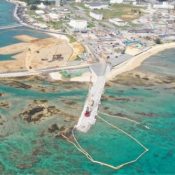
March 6, 2019 Ryukyu Shimpo
Tokyo – The Japanese government passed a revision to a drone regulation law by executive order March 5, creating a no-fly zone for small-bodied drones in the airspace above Japanese Self Defense Force and U.S. military bases.
The justification given was to target the drones use for terrorism, however since it greatly restricts the use of drones for information gathering by new organizations, the Japanese Newspaper Publishers and Editors Association (NSK) and the National Association of Commercial Broadcasters (NAB) have indicated their concerns that the media may be the real target of the revision.
It is also possible that this will restrict the news coverage of bases within Okinawa.
Junzo Yamamoto, chairman of the National Public Safety Commission, said at a press conference, “This is by no means meant to restrict the information gathering of news organizations,” and explained that, “each government agency would apply the revision suitably.”
Meanwhile, the NSK has indicated, “We fear that this will greatly restrict news coverage of the U.S. military, which is not governed by Japanese law, and will make it impossible for us to fact check statements made by them.” The Cabinet Secretariat explained that news drones would be allowed to fly with permission, however the NSK made their concerns known, stating, “This assumption is not part of the written rule, and we fear that it allows public institutions to deny flight access for no reason.”
The current law bans flights over places such as the office of the Prime Minister and nuclear power plants, and additional locations added in the revision include the Rugby World Cup Japan, The Tokyo Olympics and Paralympics, and the JSDF and U.S. military installations.
The no-fly zone includes not only the military installations themselves, but also a 300 meter perimeter around the bases, and requires obtaining permission from the commander of the facility.
Penalties for breaking this law include up to a year in prison and a 500,000 yen fine. In addition to the police and coast guard, JSDF security officials on JSDF bases are exempt.
(English translation by T&CT and Sam Grieb)
Go to Japanese
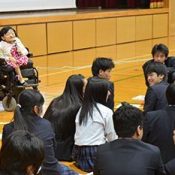
March 6, 2019 Ryukyu Shimpo
On March 5, columnist of “The View from 100 cm,” Natsuko Izena held a talk titled “What Does It Mean to Help One Another?” at Haebaru High School.
The column is serialized in Ryukyu Shimpo’s Lifestyle section.
She spoke of her own daily life and about helping one another in front of all students from Haebaru High School and Haebaru Special-Needs High School.
Izena explained that having plenty of “places where you can rely on” leads to “independence.” She said regardless of the person and “Even if it may seem that you can do anything on your own, in actuality, there are things you can rely on and can use. (Our lives) consist of (things like that).”
Izena emphasized that “reasonable accommodation” is extremely important.
She said, “It’s a little different from barrier-free (impediment removal). What’s important isn’t to equip a building with an elevator, but to think about lifting and carrying wheelchairs as a kind of reasonable accommodation.”
Following the talk, junior Tomoka Itokazu, 17, said, “I re-appreciated the importance of life involving people helping one another.”
(English translation by T&CT and Chelsea Ashimine)
Go to Japanese
March 2, 2019 The Ryukyu Shimpo
Okinawa Gov. Denny Tamaki met with Prime Minister Shinzo Abe and reported the outcome of the prefectural referendum, in which more than 70% opposed reclaiming land to construct a new base in Henoko.
The prime minister rejected the public consensus, stating: “we cannot leave behind the hazardous situation [of MCAS U.S. Marine Corps Air Station Futenma].”
Clearly, the prime minister’s statement is a contradictory one. Addressing the dangers of Futenma base is an urgent issue.
According to the current plans released by the central government in 2013, the base will be closed and returned to Okinawa “sometime after 2022.”
However, construction of the new Henoko base, the intended replacement facility for Futenma, only just begun. Furthermore, the area to be reclaimed is problemed with a soft seabed, described as having a “mayonnaise-like” consistency; As the prime minister confirmed, it requires ground-improvement work.
In one diet session, Abe was unable to produce an explicit response to a question regarding the project, and said: “It is hard to definitively say the amount of time and money that will be required.” The odds of this construction project drawing out is very high.
To keep Futenma and its hazards from being left behind, Tokyo must immediately negotiate with the U.S. to close the base; Construction of the new base in Henoko has to stop promptly.
The prefecture-wide referendum held on February 24 revealed 72.15% oppose land reclamation in Henoko, while 19.1% support it and 8.75% are undecided. Gov.
Tamaki took the results to the prime minister and the U.S. Embassy in Japan, as stipulated in the referendum ordinance.
During his meeting with Prime Minister Abe, the governor made two appeals: To respect what the Okinawans want, which was made clear by the opposition vote exceeding 70%, and halt the reclamation work accordingly; and to create a new platform for three-party discussions and include the prefecture in The Japan-U.S. Special Action Committee on Okinawa (SACO), which agreed to reduce the burden of the prefecture.
Both are reasonable requests. Voters were asked to vote on only one question—whether to reclaim land in Henoko, and over 70% opposed it. The central government has maintained that building a new base in Henoko is “the only option.” However, it is impermissible to say that something is “the only” option in politics, where issues are solved by coordinating varying interests.
It has been pointed out repeatedly that, while Okinawa shoulders 70% of all U.S. military facilities in Japan, it has been excluded from the framework to discuss reducing its burden.
Some of the major bases SACO agreed to return to Okinawa, such as Futenma, camp Kinser (Makiminato Service Area) and Naha Port Facility, has not seen any progress towards closing. This is owed to the agreement’s requirement that the bases must be moved within the prefecture, which ignored the appeals made by Okinawa.
Although Abe stated he “takes the results seriously,” he rejected the local consensus. “Over 20 years have passed since the Japan-U.S. agreement, and we cannot delay any longer,” he said. The prime minister did not comment on the two appeals made by Gov. Tamaki.
What is being left behind by Prime Minister Abe is the will of Okinawans. To turn a deaf ear to their opposition is absolutely unacceptable. It is incumbent upon the government to listen to, and act upon, the voice of the Okinawan people.
(English translation by T&CT and Monica Shingaki)
Go to Japanese
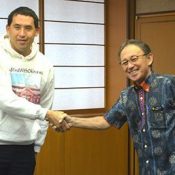
March 6, 2019 Ryukyu Shimpo
On March 5 the fourth-generation Okinawan-American Robert Kajiwara, who started the White House petition calling for signatures to request a halt to Futenma replacement facility construction in Henoko until after the prefectural referendum, paid a visit to Okinawa Governor Denny Tamaki at the Prefectural Office.
Kajiwara expressed his desire to continue his activism: “I hope to keep acting in order to support Okinawans’ will in opposition of new base construction in Henoko, even after the prefectural referendum has ended. Let’s tell the world about Okinawa’s problems.”
Governor Tamaki said: “I am thankful that you have gathered many signatures and called the world to attention. Mr. Kajiwara’s initiative has caused big waves and influenced people throughout the world.”
On February 27 after receiving the results of the prefectural referendum Kajiwara started a new signature petition titled, “Save the democracy and coral reef of Okinawa.”
Governor Tamaki brought attention to this petition and stated, “We must raise awareness that Okinawa’s problems are not limited to military base issues, and ask the world to grasp that this is an issue of democracy.”
(English translation by T&CT and Erin Jones)
Go to Japanese
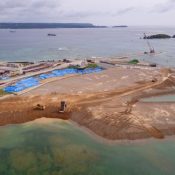
March 5, 2019 Ryukyu Shimpo
By Manato Akira
On March 4 the Okinawa Defense Bureau (ODB), which is pushing forward construction of the Futenma Replacement Facility (FRF) in Henoko, began building the K8 seawall.
The ODB also aims to start depositing soil into the new land reclamation area on March 25, and to increase the number of spots for unloading soil.
Although coral colonies live on the ocean floor where the K8 seawall is to be built and in the surrounding area, the ODB has expressed its viewpoint that construction of a portion of the seawall can proceed without transplanting the coral.
Associate Professor Nami Okubo of Tokyo Keizai University, who specializes in the biology of coral, said that the construction will “change the tidal currents and raise the fatality rates of coral on the north side” of Cape Henoko.
This is the ninth seawall as part of construction of the whole facility upon which the ODB has begun construction work.
The N4 seawall, construction of which commenced at the end of January, has now reached its full length and work on the adjacent K8 seawall has begun.
On March 4 the ODB set up silt curtains in the vicinity of the planned K8 seawall construction In order to prevent water murkiness from spreading. Stones are not being placed yet.
The total length of the K8 seawall will be 515.1 meters. Construction of the wall is planned to proceed away from the shore, 250 meters in length, stopping about 50 meters short of a coral colony.
Initially, the plan was to transplant some varities of coral living at the K8 seawall construction site, but when the Okinawa Prefectural Government (OPG) did not authorize transplantation, the ODB decided it could construct a portion of the K8 seawall without transplanting coral.
An official of the ODB Procurement Planning Division stopped short when asked about the particulars of construction, such as the period of construction and whether or not seawalls will be used as spots for soil unloading.
This official simply stated, “From here on construction progress will also depend upon factors such as the weather and marine phenomena, so I will refrain from comment.”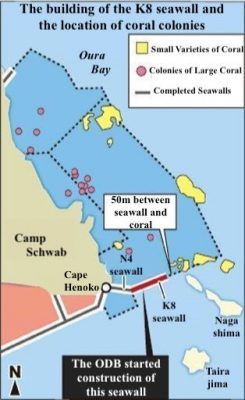
On this day, citizens opposing the FRF protested against construction work in front of a gate to Camp Schwab and in front of the pier in Awa, Nago City, at which places soil for land reclamation was being hauled.
In front of the gate citizens protested commencement of new seawall construction, shouting, “Don’t ignore Okinawans’ will.” According to the protesters in front of the gate, 327 dump trucks hauled materials into Camp Schwab.
Protesters at Awa said that 473 trucks brought soil to the pier. No protesters took out in their protest boats or canoes due to tall waves in the ocean that day.
[Commentary] ODB efforts will not accelerate construction
The Japanese government has begun construction on a new seawall as part of FRF construction in Henoko, Nago City, and it has its sights set on commencing soil deposits into a new land reclamation area on March 25.
It is clear that the government plans to use the seawall now being built as an unloading spot for soil, and is aiming to accelerate construction to make the FRF a fait accompli.
Regardless of the construction now underway on the Henoko side of Cape Henoko progressing quickly, construction on the Oura Bay side is falling behind, and the timeframe necessary to complete construction is not getting any shorter.
According to the ODB’s application to the OPG for a land reclamation permit, the initial plan by the central government set a timeframe of the greater part of 5 years for construction on the Oura Bay side of Cape Henoko.
Because the government planned to run construction in the shallower waters of the Henoko side concurrently with that on the Oura Bay side, the Henoko side construction would not affect this construction period.
In a written statement submitted to the Ministry of Land, Infrastructure, Transport and Tourism (MLIT), the OPG pointed out, “As long as construction on the Oura Bay side seawalls has not commenced, the timeframe necessary for construction of the new Henoko base is the same as if construction never started.”
Actually, the government cannot start a majority of the construction work due to the discovery of soft ground on the Oura Bay side, and can only manifest a portion of the planned seawalls.
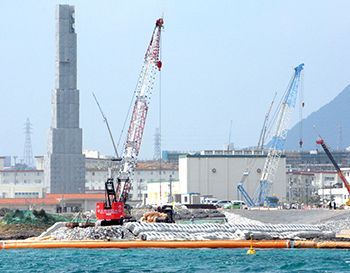
On March 4 around 1:30 p.m. workers set up silt curtains in preparation for soil deposits at the K8 seawall.
It is also important to note that prior to construction, dealing with the soft ground is expected to take five years minimum. If only Henoko side construction proceeds, the ODB’s progress will not result in the FRF being completed any sooner.
Some have indicated that due to these facts, construction of the FRF in Henoko will not lead to a quick closure and return of Futenma Air Station.
The foundation of the Japanese government’s argument, that either Futenma Air Station will be permanent or it will be relocated to Henoko, is shaken.
In the February prefectural referendum about 70 percent of voters said they oppose land reclamation work in Henoko. The Japanese government is disregarding the Okinawa referendum results and the land reclamation’s effects on the natural environment, yet it can be said that the government continuing construction work will not result in a shorter construction timeframe.
(English translation by T&CT and Erin Jones)
Go to Japanese
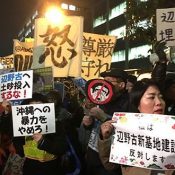
March 2, 2019 Ryukyu Shimpo
(Tokyo) On March 1, a demonstration named “#0301 Don’t Bury Okinawa: Tokyo Mass Protest” was held in front of the Prime Minister’s office in Tokyo.
The demonstration was held in the wake of a prefectural referendum in Okinawa, for which voting commenced on February 24, on the issue of land reclamation as part of the construction of a new military base in Henoko, Nago.
The referendum showed more than 70% of voters opposing the reclamation. Answering the call of volunteers interested in the cause, enough people gathered to fill the whole sidewalk and raised their voices, saying, “Don’t bury Okinawa!” and calling for a stop to the new base construction.
Protests opposing the resumption of nuclear power plant operations and other issues are held in front of the Prime Minister’s office every Friday, but on this day the police beefed up their usual security and tensions were high as they faced off with the protestors.
Jinshiro Motoyama, representative of the “Henoko” Okinawa Prefectural Referendum Committee, who attended the protest, urged more people to take action, saying, “I came thinking there would be more people here.
The Prime Minister and Chief Cabinet Secretary will never listen to us at this rate!” He expressed his hope to expand the movement to block the base construction, telling the attendees, “You should talk to people around you with different perspectives [about the base issue] starting by asking what they think about the referendum.”
The chanting protesters responded to Motoyama’s urging, saying, “That the harassment [of Okinawa] continues is the fault of all the people who stand by watching and pretending nothing is happening.
It’s our responsibility to push away the feet that are trampling on Okinawa.”
(English translation by T&CT and Sandi Aritza)
Go to Japanese

March 5, 2019 Ryukyu Shimpo
Wedding planners from four bridal companies in India, where the demand for foreign resort weddings has been increasing, visited Okinawa to explore the possibilities of hosting events in Okinawa.
Resort weddings have become popular with the wealthy class of Indians, with a couple spending around 50 million yen on average.
One planner who visited said optimistically, “I can already imagine the wedding.
I want to have it in Okinawa.” Okinawa sees India as a “potential market,” and hopes that by attracting visitors to the island for weddings they can introduce the country to its hotels and sightseeing locations. Both sides appear to be gazing warmly at the other.
Four people from wedding planning companies in the Indian megalopolis Delhi came to observe. In September of 2018, Japan National Tourism Organization (JNTO) Delhi office Chief Kenichi Takano contacted tourism industry contacts in Okinawa and set up the visit.
The group visited ANA Intercontinental Manza Beach Resort, Rizzan Sea Park Hotel Tancha Bay, and Shigira Resort in Miyakojima City.
In recent years, resort weddings have been on the rise in India, with Thailand and Bali in Indonesia being popular destinations. In particular, luxury hotels and beach resorts are hot spots. The weddings see roughly 150 people make come for three nights, four days, for a total expenditure that surpasses 50 million yen.
These Indian resort weddings often combine the traditional ceremonies held onsite along with the vibrant decorations, and top it all off with live music and DJ-led dancing.
Indian cuisine is a must for food, and there must be accommodation for vegetarians. The visiting group asked about past weddings, costs, and the pros and cons of different options.
One planner, Yogesh Kantiwar, said, “I can imagine the Indian red and yellow along with the blue of Okinawa making a rainbow.”
Tsunetaka Ishimine from IHG/ANA Hotel Group Japan, who led the tour of the Manza Beach Resort, said, “We get almost no visitors from India. Since we can arrange this, I would like to try and make it happen.”
(English translation by T&CT and Sam Grieb)
Go to Japanese
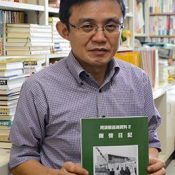
March 1, 2019 Ryukyu Shimpo
On February 28, the “Lobbying Journal” which covers the activities of late Shoko Ahagon, who took part in the land dispute in Ie Island under U.S. military rule, was published.
The journal details the lobby activities by residents of Ie Village, Okinawa Prefecture that took place in front of the Ryukyu government building in Naha City, along with the “beggars’ march,” a non-violent protest in which people traveled the length of the Main Island of Okinawa.
The journal records the events that took place between June and October of 1955.
Okinawa International University Professor of Okinawan Modern History Atsushi Toriyama, who is a part of the Shoko Ahagon Resource Research Association, and others edited the journal.
The “beggars’ march” took place between July 21, 1955 and early 1956.
Newspaper reports at the time trailed off at the end of July 1955 so the activities beyond that point by those in the march had been unknown.
But the “Lobbying Journal” reveals that they were traveling around Kunigami in September.
The journal also details the exchange between the lobby group and the Ryukyu government.
Concerning the lobby group, the journal writes that the Ryukyu government Vice Chairman at the time, Tatsubin Yogi had said, “(If we cannot resolve the issue of removing residents who are protesting the land condemnation, then) I am prepared to resign.” Professor Toriyama commented that “The Ryukyu government was caught between conflicting demands (from the U.S. military and residents). They wanted to do something but did not have the authority.”
“Lobbying Journal” had been stored at the Wabiai no Sato that traces Ahagon’s footsteps and passes on the history of Ie Island.
It seems that the journal was written by several islanders.
Professor Toriyama said, “Combining the journal with documents from the time, it gives us a solid understanding of what the situation was like back then.”
The Wabiai no Sato held a workshop on the “Lobbying Journal” at 3 p.m. on March 2 and 9 a.m. on March 3 at the Ie Village Agricultural Development Centre.
Starting at 10 a.m. on March 10, Professor Toriyama is to provide commentary on the topic.
There will be 500 copies of the book, which cost 800-yen each including tax. For more information contact Wabiai no Sato at 0980 (49) 3047.
(English translation by T&CT and Chelsea Ashimine)
Go to Japanese


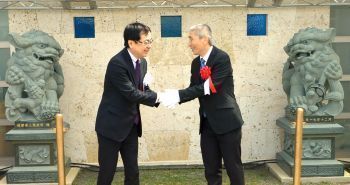











 Webcam(Kokusai Street)
Webcam(Kokusai Street)


